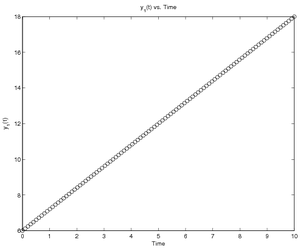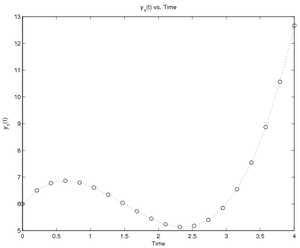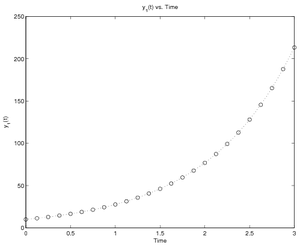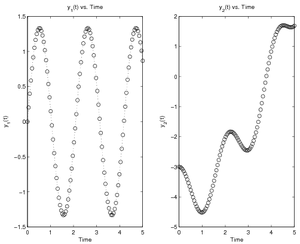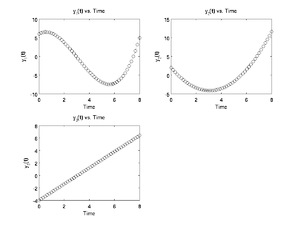Difference between revisions of "MATLAB:Ordinary Differential Equations/Examples"
| (4 intermediate revisions by the same user not shown) | |||
| Line 8: | Line 8: | ||
<center><math> | <center><math> | ||
\begin{align} | \begin{align} | ||
| − | \frac{dy}{dt}= | + | \frac{dy}{dt}=C\end{align} |
| − | \end{align} | ||
</math></center> | </math></center> | ||
| − | where <math> | + | where <math>C</math> is some constant, you can provide the differential equation |
with a function called <code>ConstDiff.m</code> that contains the code: | with a function called <code>ConstDiff.m</code> that contains the code: | ||
<source lang="matlab"> | <source lang="matlab"> | ||
| − | function dydt = ConstDiff(t, y, | + | function dydt = ConstDiff(t, y, C) |
% Differential equation for constant growth | % Differential equation for constant growth | ||
% t is time | % t is time | ||
% y is the state vector | % y is the state vector | ||
| − | % | + | % C contains any required constants |
% dydt must be a column vector | % dydt must be a column vector | ||
| − | dydt = | + | dydt = C(1); % or just C since there is only one |
</source> | </source> | ||
| Line 38: | Line 37: | ||
tspan = linspace(0, 10); | tspan = linspace(0, 10); | ||
yinit = 6; | yinit = 6; | ||
| − | + | C = 1.2; | |
% Determine if states should be plotted | % Determine if states should be plotted | ||
| Line 45: | Line 44: | ||
%% Under the hood | %% Under the hood | ||
% Use ODE function of choice to get output times and states | % Use ODE function of choice to get output times and states | ||
| − | DE = eval(sprintf('@(t, y, | + | DE = eval(sprintf('@(t, y, C) %s(t,y,C)', DiffFileName)) |
| − | [tout, yout] = ode45(@(t,y) DE(t,y, | + | [tout, yout] = ode45(@(t,y) DE(t,y,C), tspan, yinit); |
% Plot results | % Plot results | ||
| Line 62: | Line 61: | ||
<center><math> | <center><math> | ||
\begin{align} | \begin{align} | ||
| − | \frac{dy}{dt}&= | + | \frac{dy}{dt}&=\alpha t^2+\beta t+\gamma |
\end{align} | \end{align} | ||
</math></center> | </math></center> | ||
| Line 68: | Line 67: | ||
written in a file called <code>TimeDiff.m</code> | written in a file called <code>TimeDiff.m</code> | ||
<source lang="matlab"> | <source lang="matlab"> | ||
| − | function dydt = TimeDiff(t, y, | + | function dydt = TimeDiff(t, y, C) |
% Differential equation for time-based polynomial derivative | % Differential equation for time-based polynomial derivative | ||
% t is time | % t is time | ||
% y is the state vector | % y is the state vector | ||
| − | % | + | % C contains any required constants |
% dydt must be a column vector | % dydt must be a column vector | ||
| − | dydt = polyval( | + | dydt = polyval(C, t); |
</source> | </source> | ||
| Line 93: | Line 92: | ||
tspan = linspace(0, 4, 20); | tspan = linspace(0, 4, 20); | ||
yinit = 6; | yinit = 6; | ||
| − | + | C = [2 -6 3]; | |
% Determine if states should be plotted | % Determine if states should be plotted | ||
| Line 100: | Line 99: | ||
%% Under the hood | %% Under the hood | ||
% Use ODE function of choice to get output times and states | % Use ODE function of choice to get output times and states | ||
| − | DE = eval(sprintf('@(t, y, | + | DE = eval(sprintf('@(t, y, C) %s(t,y,C)', DiffFileName)) |
| − | [tout, yout] = ode45(@(t,y) DE(t,y, | + | [tout, yout] = ode45(@(t,y) DE(t,y,C), tspan, yinit); |
% Plot results | % Plot results | ||
| Line 116: | Line 115: | ||
<center><math> | <center><math> | ||
\begin{align} | \begin{align} | ||
| − | \frac{dy}{dt}= | + | \frac{dy}{dt}=C\cdot y |
\end{align} | \end{align} | ||
</math></center> | </math></center> | ||
| − | where <math> | + | where <math>C</math> is again some constant. |
In that case, the function may be written in a file called <code>PopDiff.m</code> as follows: | In that case, the function may be written in a file called <code>PopDiff.m</code> as follows: | ||
<source lang="matlab"> | <source lang="matlab"> | ||
| − | function dydt = PopDiff(t, y, | + | function dydt = PopDiff(t, y, C) |
% Differential equation for population growth | % Differential equation for population growth | ||
% t is time | % t is time | ||
% y is the state vector | % y is the state vector | ||
| − | % | + | % C contains any required constants |
% dydt must be a column vector | % dydt must be a column vector | ||
| − | dydt = | + | dydt = C(1)*y(1); % or just C*y since both are 1x1 |
</source> | </source> | ||
| Line 146: | Line 145: | ||
tspan = linspace(0, 3, 25); | tspan = linspace(0, 3, 25); | ||
yinit = 10; | yinit = 10; | ||
| − | + | C = 1.02; | |
% Determine if states should be plotted | % Determine if states should be plotted | ||
| Line 153: | Line 152: | ||
%% Under the hood | %% Under the hood | ||
% Use ODE function of choice to get output times and states | % Use ODE function of choice to get output times and states | ||
| − | DE = eval(sprintf('@(t, y, | + | DE = eval(sprintf('@(t, y, C) %s(t,y,C)', DiffFileName)) |
| − | [tout, yout] = ode45(@(t,y) DE(t,y, | + | [tout, yout] = ode45(@(t,y) DE(t,y,C), tspan, yinit); |
% Plot results | % Plot results | ||
| Line 163: | Line 162: | ||
| − | ==Multiple Variable Models== | + | ===Multiple Variable Models=== |
[[File:ODETwoDiffPlot.png|thumb|Result for system with two variables]] | [[File:ODETwoDiffPlot.png|thumb|Result for system with two variables]] | ||
| Line 173: | Line 172: | ||
<center><math> | <center><math> | ||
\begin{align} | \begin{align} | ||
| − | \frac{dy_1}{dt}&= | + | \frac{dy_1}{dt}&=\alpha\cos(\beta t) & |
| − | \frac{dy_2}{dt}&= | + | \frac{dy_2}{dt}&=\gamma y_1+\delta t |
\end{align} | \end{align} | ||
</math></center> | </math></center> | ||
| Line 180: | Line 179: | ||
matrix as the output: | matrix as the output: | ||
<source lang="matlab"> | <source lang="matlab"> | ||
| − | function dydt = TwoDiff(t, y, | + | function dydt = TwoDiff(t, y, C) |
% Differential equations for two variables | % Differential equations for two variables | ||
% t is time | % t is time | ||
% y is the state vector | % y is the state vector | ||
| − | % | + | % C contains any required constants |
% dydt must be a column vector | % dydt must be a column vector | ||
dydt = [... | dydt = [... | ||
| − | + | C(1)*cos(C(2)*t);... | |
| − | + | C(3)*y(1)+C(4)*t]; | |
</source> | </source> | ||
| Line 213: | Line 212: | ||
tspan = linspace(0, 5); | tspan = linspace(0, 5); | ||
yinit = [0 -3]'; | yinit = [0 -3]'; | ||
| − | + | C = [4 3 -2 0.5]; | |
% Determine if states should be plotted | % Determine if states should be plotted | ||
| Line 220: | Line 219: | ||
%% Under the hood | %% Under the hood | ||
% Use ODE function of choice to get output times and states | % Use ODE function of choice to get output times and states | ||
| − | DE = eval(sprintf('@(t, y, | + | DE = eval(sprintf('@(t, y, C) %s(t,y,C)', DiffFileName)) |
| − | [tout, yout] = ode45(@(t,y) DE(t,y, | + | [tout, yout] = ode45(@(t,y) DE(t,y,C), tspan, yinit); |
% Plot results | % Plot results | ||
| Line 229: | Line 228: | ||
</source> | </source> | ||
| − | == Higher Order Differential Equations == | + | |
| + | === Higher Order Differential Equations === | ||
| + | [[File:ODEJerkDiffPlot.png|thumb|Result using constant third derivative.]] | ||
The system must be written in terms of first-order | The system must be written in terms of first-order | ||
differential equations only. To solve a system with | differential equations only. To solve a system with | ||
| Line 237: | Line 238: | ||
<center><math> | <center><math> | ||
\begin{align} | \begin{align} | ||
| − | j&=\frac{d^3y}{dt^3}= | + | j&=\frac{d^3y}{dt^3}=C |
\end{align} | \end{align} | ||
</math></center> | </math></center> | ||
| Line 248: | Line 249: | ||
\frac{dy_2}{dt}&=\frac{d^2y_1}{dt^2}=\frac{d^2y}{dt^2}=y_3 & &\longrightarrow & | \frac{dy_2}{dt}&=\frac{d^2y_1}{dt^2}=\frac{d^2y}{dt^2}=y_3 & &\longrightarrow & | ||
\frac{dy_2}{dt}&=y_3\\ | \frac{dy_2}{dt}&=y_3\\ | ||
| − | \frac{dy_3}{dt}&=\frac{d^2y_2}{dt^2}=\frac{d^3y_1}{dt^3}=\frac{d^3y}{dt^3}=j= | + | \frac{dy_3}{dt}&=\frac{d^2y_2}{dt^2}=\frac{d^3y_1}{dt^3}=\frac{d^3y}{dt^3}=j=C & |
&\longrightarrow & | &\longrightarrow & | ||
| − | \frac{dy_3}{dt}&= | + | \frac{dy_3}{dt}&=C |
\end{align}</math></center> | \end{align}</math></center> | ||
Notice how the derivatives cascade so that the constant jerk equation | Notice how the derivatives cascade so that the constant jerk equation | ||
| Line 256: | Line 257: | ||
differential file <code>JerkDiff.m</code> would thus be: | differential file <code>JerkDiff.m</code> would thus be: | ||
<source lang=matlab> | <source lang=matlab> | ||
| − | function dydt = JerkDiff(t, y, | + | function dydt = JerkDiff(t, y, C) |
% Differential equations for constant jerk | % Differential equations for constant jerk | ||
% t is time | % t is time | ||
% y is the state vector | % y is the state vector | ||
| − | % | + | % C contains any required constants |
% dydt must be a column vector | % dydt must be a column vector | ||
dydt = [... | dydt = [... | ||
y(2); ... | y(2); ... | ||
y(3);... | y(3);... | ||
| − | + | C(1)]; % or just C since there is only one | |
</source> | </source> | ||
to represent the three equations given above. Note that in this system, | to represent the three equations given above. Note that in this system, | ||
| Line 284: | Line 285: | ||
tspan = linspace(0, 8, 50); | tspan = linspace(0, 8, 50); | ||
yinit = [6 2 -4]; | yinit = [6 2 -4]; | ||
| − | + | C = 1.3; | |
% Determine if states should be plotted | % Determine if states should be plotted | ||
| Line 291: | Line 292: | ||
%% Under the hood | %% Under the hood | ||
% Use ODE function of choice to get output times and states | % Use ODE function of choice to get output times and states | ||
| − | DE = eval(sprintf('@(t, y, | + | DE = eval(sprintf('@(t, y, C) %s(t,y,C)', DiffFileName)) |
| − | [tout, yout] = ode45(@(t,y) DE(t,y, | + | [tout, yout] = ode45(@(t,y) DE(t,y,C), tspan, yinit); |
% Plot results | % Plot results | ||
Latest revision as of 18:01, 30 November 2014
The following examples show different ways of setting up and solving initial value problems in MATLAB. It is part of the page on Ordinary Differential Equations in MATLAB.
Contents
Examples
Note - each example began with the Templates provided at this web site. Some comments have been removed from the templates to conserve space while some comments may have been added to provide a clearer explanation of the process for a particular example.
Constant Rate of Change
If the dependent variable has a constant rate of change:
where \(C\) is some constant, you can provide the differential equation
with a function called ConstDiff.m that contains the code:
function dydt = ConstDiff(t, y, C)
% Differential equation for constant growth
% t is time
% y is the state vector
% C contains any required constants
% dydt must be a column vector
dydt = C(1); % or just C since there is only one
You could calculate answers using this model with the following code
called RunConstDiff.m,
which assumes there are 100 evenly spaced times between 0 and 10, the
initial value of \(y\) is 6, and the rate of change is 1.2:
% Initialize workspace and graph
clear; format short e; figure(1); clf
% Set name of file containing derivatives
DiffFileName = 'ConstDiff';
% Set up time span, initial value(s), and constant(s)
% Note: Variables should be in columns
tspan = linspace(0, 10);
yinit = 6;
C = 1.2;
% Determine if states should be plotted
PlotStates = 1;
%% Under the hood
% Use ODE function of choice to get output times and states
DE = eval(sprintf('@(t, y, C) %s(t,y,C)', DiffFileName))
[tout, yout] = ode45(@(t,y) DE(t,y,C), tspan, yinit);
% Plot results
if PlotStates
figure(1); clf
StatePlotter(tout, yout)
end
Time-dependent Rate of Change
If the dependent variable's rate of change is some function of time, this can be easily written using MATLAB. For example, if the differential equation is some quadratic function given as:
then the function providing the values of the derivative may be
written in a file called TimeDiff.m
function dydt = TimeDiff(t, y, C)
% Differential equation for time-based polynomial derivative
% t is time
% y is the state vector
% C contains any required constants
% dydt must be a column vector
dydt = polyval(C, t);
You could calculate answers using this model with the following code
called RunTimeDiff.m,
which assumes there are 20 evenly spaced times between 0 and 4, the
initial value of \(y\) is 6, and the polynomial is defined by the vector
[2 -6 3]:
% Initialize workspace and graph
clear; format short e; figure(1); clf
% Set name of file containing derivatives
DiffFileName = 'TimeDiff';
% Set up time span, initial value(s), and constant(s)
% Note: Variables should be in columns
tspan = linspace(0, 4, 20);
yinit = 6;
C = [2 -6 3];
% Determine if states should be plotted
PlotStates = 1;
%% Under the hood
% Use ODE function of choice to get output times and states
DE = eval(sprintf('@(t, y, C) %s(t,y,C)', DiffFileName))
[tout, yout] = ode45(@(t,y) DE(t,y,C), tspan, yinit);
% Plot results
if PlotStates
StatePlotter(tout, yout)
end
Population Growth
For population growth, the rate of change of population is dependent upon the number of people as well as some constant of proportionality:
where \(C\) is again some constant.
In that case, the function may be written in a file called PopDiff.m as follows:
function dydt = PopDiff(t, y, C)
% Differential equation for population growth
% t is time
% y is the state vector
% C contains any required constants
% dydt must be a column vector
dydt = C(1)*y(1); % or just C*y since both are 1x1
The following code, RunPopDiff.m, will calculate the population for
a span of 3 seconds with 25
points for the population model above with an initial population of 10
and a constant of proportionality of 1.02:
% Initialize workspace and graph
clear; format short e; figure(1); clf
% Set name of file containing derivatives
DiffFileName = 'PopDiff';
% Set up time span, initial value(s), and constant(s)
% Note: Variables should be in columns
tspan = linspace(0, 3, 25);
yinit = 10;
C = 1.02;
% Determine if states should be plotted
PlotStates = 1;
%% Under the hood
% Use ODE function of choice to get output times and states
DE = eval(sprintf('@(t, y, C) %s(t,y,C)', DiffFileName))
[tout, yout] = ode45(@(t,y) DE(t,y,C), tspan, yinit);
% Plot results
if PlotStates
StatePlotter(tout, yout)
end
Multiple Variable Models
It is possible to solve multiple-variable systems by making sure the differential function returns values for each of the variables. For instance, in the following system the first variable's rate of change depends only on time while the second is dependent upon both time and the first variable:
The differential file TwoDiff.m for this system will have a 2x1
matrix as the output:
function dydt = TwoDiff(t, y, C)
% Differential equations for two variables
% t is time
% y is the state vector
% C contains any required constants
% dydt must be a column vector
dydt = [...
C(1)*cos(C(2)*t);...
C(3)*y(1)+C(4)*t];
Finally, if you have systems with multiple dependent variables, just be sure to put the initial conditions in a column vector. For example, with the system defined as:
you could use the following script called RunTwoDiff to solve for both
\(y_1\) and \(y_2\) assuming \(y_1\) starts as 0 and \(y_2\) starts at -3:
% Initialize workspace and graph
clear; format short e; figure(1); clf
% Set name of file containing derivatives
DiffFileName = 'TwoDiff';
% Set up time span, initial value(s), and constant(s)
% Note: Variables should be in columns
tspan = linspace(0, 5);
yinit = [0 -3]';
C = [4 3 -2 0.5];
% Determine if states should be plotted
PlotStates = 1;
%% Under the hood
% Use ODE function of choice to get output times and states
DE = eval(sprintf('@(t, y, C) %s(t,y,C)', DiffFileName))
[tout, yout] = ode45(@(t,y) DE(t,y,C), tspan, yinit);
% Plot results
if PlotStates
StatePlotter(tout, yout)
end
Higher Order Differential Equations
The system must be written in terms of first-order differential equations only. To solve a system with higher-order derivatives, you will first write a cascading system of simple first-order equations then use them in your differential file. For example, assume you have a system characterized by constant jerk:
The first thing to do is write three first-order differential equations to represent the third-order equation:
Notice how the derivatives cascade so that the constant jerk equation
can now be written as a set of three first-order equations. The
differential file JerkDiff.m would thus be:
function dydt = JerkDiff(t, y, C)
% Differential equations for constant jerk
% t is time
% y is the state vector
% C contains any required constants
% dydt must be a column vector
dydt = [...
y(2); ...
y(3);...
C(1)]; % or just C since there is only one
to represent the three equations given above. Note that in this system, \(y_1\) represents the position, \(y_2\) represents the velocity, and \(y_3\) represents the acceleration. This type of cascading system will show up often when modeling equations of motion.
The following script, RunJerkDiff.m, calculates the position,
velocity, and speed over a period of 8 seconds assuming an initial
position of 6, and initial velocity of 2, an initial acceleration of
-4, and a constant jerk of 1.3:
% Set name of file containing derivatives
DiffFileName = 'JerkDiff';
% Set up time span, initial value(s), and constant(s)
% Note: Variables should be in columns
tspan = linspace(0, 8, 50);
yinit = [6 2 -4];
C = 1.3;
% Determine if states should be plotted
PlotStates = 1;
%% Under the hood
% Use ODE function of choice to get output times and states
DE = eval(sprintf('@(t, y, C) %s(t,y,C)', DiffFileName))
[tout, yout] = ode45(@(t,y) DE(t,y,C), tspan, yinit);
% Plot results
if PlotStates
StatePlotter(tout, yout)
end
Note in the above that the StatePlotter function is called to plot the states. That code is:
function StatePlotter(Time, States)
StateCount = size(States, 2);
NumCols = ceil(sqrt(StateCount));
NumRows = ceil(StateCount / NumCols);
clf;
for PlotNumber = 1:StateCount
subplot(NumRows, NumCols, PlotNumber);
plot(Time, States(:,PlotNumber), 'ko:');
xlabel('Time');
ylabel(sprintf('y_{%0.0f}(t)', PlotNumber))
title(sprintf('y_{%0.0f}(t) vs. Time', PlotNumber));
end
Questions
Post your questions by editing the discussion page of this article. Edit the page, then scroll to the bottom and add a question by putting in the characters *{{Q}}, followed by your question and finally your signature (with four tildes, i.e. ~~~~). Using the {{Q}} will automatically put the page in the category of pages with questions - other editors hoping to help out can then go to that category page to see where the questions are. See the page for Template:Q for details and examples.
